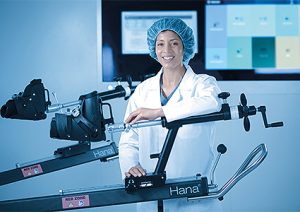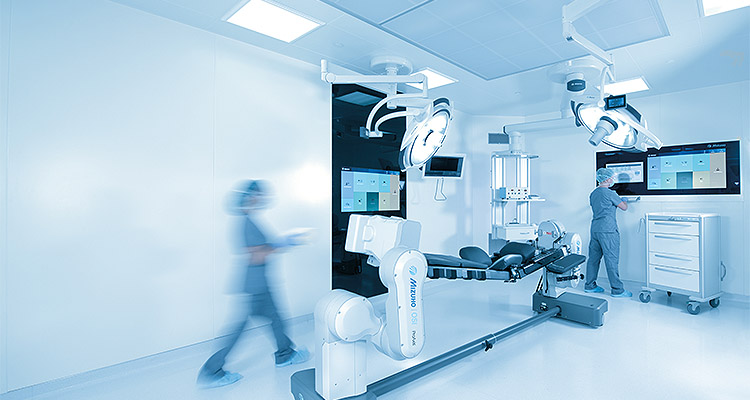Mizuho OSI is a market leader that operates with a difference
If we take a trip back 50 or so years, as an orthopedic patient heading to surgery, you could expect to be laid out on towels across a flat surface with your body positioned in place by pieces of foam or sandbags. This was before Mizuho OSI came along, and developed the first specialty spinal operating table for such procedures. The company started out in 1979, in the niche market of producing pads and supportive devices to be used in operating rooms, and as it has grown, it has brought years and years of innovation to the orthopedic table market, of which it is the unmistakable leader.

“Our methodology is what really sets us apart,” opens Kevin Thorne, Vice President of Operations and Services. “To obtain a greater insight into the way surgeons work in operating rooms, our product team spends time observing and filming them during their day-to-day procedures. We then review the footage together, to understand why they do exactly what they do; from reaching across the room to holding patients in a specific way, to ensure that we have questioned every step of the process.
“In addition to this, we work with key opinion leaders in the field who advise us on how to best approach and solve any problems that we have highlighted, so that our team can deliver the perfect solutions. Once we have ascertained our plan of action, we feed it back to the surgeons we have worked with for their opinions. Streamlining the surgeon’s actions and ensuring patient safety is paramount to what we do. Our approach to product development is very much surgeon-focused, which is aligned with our mission statement to improve the outcomes for patients undergoing surgery.
Impressive growth
“The culture at Mizuho OSI is heavily based around innovation, with the shared ideology of acting boldly and tackling the status quo,” he explains. “Immediately second to that, is our desire to support our customers, who we will do anything for. An example of this cropped up last week, when one of the delivery companies we use had an unfortunate incident and ultimately destroyed one of our tables during transit. In our drop-everything-to-take-care mentality, we pulled the very next unit off the line at the plant and shipped it out that afternoon, meaning our client was only delayed by an extra couple of days. This is the embodiment of our slogan ‘dare to go further, care to do more.’
“We aren’t about just staying stable, or simply being comfortable with our past achievements, as we’re very growth oriented and always looking for what we can do next to push the envelope. Our market space grows at around 3.5 percent each year, whereas the business itself has been expanding at a rate significantly greater than that, for the last 20 years. We are constantly striving to develop our aggressive market to grow at a faster pace.”
Kevin started his career in the military as a naval officer working on submarines, so engineering has always been a part of his background. When he left, he moved into aerospace and defense, which was swiftly followed by a path into medical devices and a position with ADAC Laboratories. It was here that he met the colleagues that invited him to join Mizuho OSI seven years ago.
“We have steadily continued to grow,” he states.” The manufacturing practices in place when I arrived, were that of a far smaller company; they were still work-order based, for example, and there were no lean lines or master supply agreements with our key suppliers. We were also lacking a strategy to whittle down our supply chain partners who could grow with the business, it was more of a ‘where could we get that was close and cheap’ approach. The machine shop, which has now been revitalized to a world-class standard, hadn’t been invested in for some time, and we weren’t sure whether it was worth changing, or repurposing it, instead of relying on our external supply chain.
Disrupting the status quo

“I hold a somewhat contrary approach to manufacturing, in that I don’t believe in outsourcing and offshoring. I believe that insourcing and onshoring are the most stable and ultimately cost effective solutions. The few cents that are saved by manufacturing in a low cost region aren’t worth the lengthy supply chain that it comes with. You open yourself up to more risks and potential disruptions that make the savings meaningless. I don’t believe we’ll ever solely support ourselves, because I think spreading the risk between internal and external resources is a sound strategy, from a reliability and resilience perspective. If something happens to us, we have suppliers who can pick up the load, and vice versa. Having that versatility gives us the ability to continue to produce products regardless of the environmental conditions is key to our strategic planning.
“Some people are criticizing lean manufacturing as one of the culprits of the supply chain disruptions we’ve been seeing,” Kevin continues. “In practicing just-in-time deliveries, it only takes one glitch in the source to shut down the entire system. However, one of the principles of the lean approach is to account for your variation or risk with buffer stock. Many in the industry underestimated the supply chain risks, but we are now using inventory to fundamentally buy ourselves time; time to come up with alternate sources, suppliers, or solutions if something goes wrong in the supply chain.
“Once we release our products, they have a design life cycle of ten years, so we don’t need to worry about inhouse obsolescence as much as others do. We could purchase a years’ worth of stock and it’s going to be fine for the foreseeable future. I think a lot of people could benefit greatly from clearly understanding their risk profiles and, if necessary, abandoning some of the sacred cows, such as inventory levels. Some say that we are in unprecedented times, and the world is different to what it was ten years ago. These times require people like us to think with open minds and challenge some of the thumb rules of the past. Those who can’t do this will struggle, whereas those who can, will do well into the future,” he concludes.
